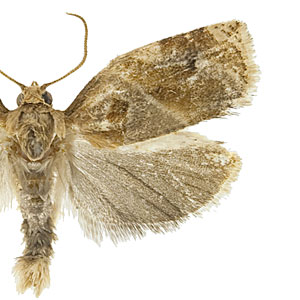Adult Recognition

FWL: 7.0-10.0 mm (male); 9.0-11.0 mm (female)
Forewing ground color is pale pinkish brown. Forewing markings are dark reddish brown and include a basal patch and a well-defined median fascia that is narrow at the costa and broadened at the dorsum. The subterminal fascia gives the appearance of a costal spot on many individuals. Hindwings are grayish brown. Males have a forewing costal fold.
Male genitalia are characterized by a large, parallel-sided uncus, rounded valva, and well-defined sacculus with a short projection. Female genitalia are characterized by a very long ductus bursae with cestum and a signum in the round corpus bursae.
Archips xylosteana can appear similar to other Archips, including: Archips betulana, Archips crataegana, Archips grisea, Archips magnoliana, Archips oporana, Archips podana, and Archips rosana. A genitalic dissection can be used to confirm identity.
Larval Morphology

Last instar larvae are greenish gray to whitish gray. The head and prothoracic shield are black or dark brown and are separated by a white line. Thoracic legs are dark brown or black.
Biology

Archips xylosteana completes a single generation per year. Adults are present in late June to mid-August.
Females deposit eggs in masses on branches or tree trunks. Eggs overwinter and first instar larvae hatch the following spring. Early instars feed on leaves and buds while later instars produce a leaf roll and skeletonize the leaf from inside. Pupation occurs from mid-May to June in a folded leaf and adults emerge in 9-12 days.
In Europe this species is considered a minor pest of fruit trees, where it can cause damage to buds and new foliage. Larvae may also feed on fruitlets causing superficial damage.
Host plants
Larvae of Archips xylosteana feed on a variety of tree species.
| Family | Genus/species | Common name |
| Aceraceae | Acer L. | maple |
| Betulaceae | Alnus Mill. | alder |
| Betulaceae | Betula L. | birch |
| Betulaceae | Corylus avellana L. | common filbert |
| Caprifoliaceae | Lonicera periclymenum L. | European honeysuckle |
| Caprifoliaceae | Lonicera L. | honeysuckle |
| Clusiaceae | Hypericum L. | St. Johnswort |
| Cornaceae | Cornus controversa Hemsl. ex Prain | giant dogwood |
| Fagaceae | Castanea crenata Siebold & Zucc. | Japanese chestnut |
| Fagaceae | Castanea Mill. | chestnut |
| Fagaceae | Quercus acutissima Carruth. | sawtooth oak |
| Fagaceae | Quercus cerris L. | European turkey oak |
| Fagaceae | Quercus dentata Thunb. | Daimyo oak |
| Fagaceae | Quercus robur L. | English oak |
| Fagaceae | Quercus serrata Thunb. | bao li |
| Fagaceae | Quercus L. | oak |
| Oleaceae | Fraxinus excelsior L. | European ash |
| Pinaceae | Abies Mill. | fir |
| Rosaceae | Crataegus L. | hawthorn |
| Rosaceae | Malus domestica Borkh. | apple |
| Rosaceae | Malus pumila Mill. | paradise apple |
| Rosaceae | Prunus armeniaca L. | apricot |
| Rosaceae | Prunus avium (L.) L. | sweet cherry |
| Rosaceae | Prunus serrulata Lindl. | Japanese flowering cherry |
| Rosaceae | Prunus L. | |
| Rosaceae | Pyrus pyrifolia (Burm. f.) Nakai | Chinese pear |
| Rosaceae | Pyrus ussuriensis Maxim. | |
| Rosaceae | Rubus L. | raspberry |
| Rosaceae | Sorbus aucuparia L. | European mountain ash |
| Rutaceae | Citrus L. | citrus |
| Salicaceae | Salix cinerea L. | large gray willow |
| Salicaceae | Salix L. | willow |
| Tiliaceae | Tilia L. | basswood |
| Ulmaceae | Ulmus davidiana Planch. | Japanese elm |
| Ulmaceae | Ulmus L. | elm |
Distribution

Archips xylosteana is distributed throughout Europe, Asia (China, Iran, Japan, Kazakhstan, Korea, Siberia, Turkey), and northern Africa (Algeria). It was first discovered in North America (Newfoundland, Canada) in 2005.
References

Beeke, H. and D. J. De Jong. 1991. Identification of Larvae and Pupae, pp. 65-76. In L. P. S. van der Geest and H. H. Evenhius [eds.], Tortricid Pests: Their Biology, Natural Enemies, and Control. World Crop Pests, Vol. 5. Elsevier, Amsterdam.
Bradley, J. D., W. G. Tremewan and A. Smith. 1973. British Tortricoid Moths - Cochylidae and Tortricidae: Tortricinae. The Ray Society, London, England.
Davis, E. E., R. C. Venette and E. M. Albrecht. 2006. Oak commodity based survey reference. USDA - CAPS Commodity Reference Guide.
Hoebeke, E. R., A. G. Wheeler, Jr. and J. W. Brown. 2008. Archips xylosteana (L.) (Lepidoptera: Tortricidae), a Palearctic leafroller new to North America. Proceedings of the Entomological Society of Washington. 110: 789-795.
Yasuda, T. 1975. The Tortricinae and Sparganothinae of Japan (Lepidoptera: Tortricidae). Part II. Bulletin of the University of Osaka Prefecture, Series B. 27: 79-251.
Photo Credits

Fig. 5: Sander van der Molen
Figs. 6, 8, 9: Gyorgy Csoka, Hungary Forest Research Institute, Bugwood.org
Fig. 7: Fabio Stergulc, Universita di Udine, Bugwood.org
Figs. 10-11: Milan Zubrik, Forest Research Institute - Slovakia, Bugwood.org












